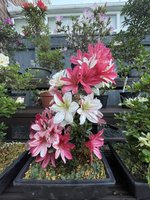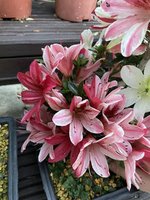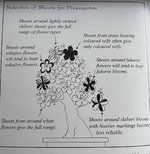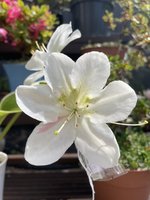To replace them, yes. But let's backtrack a bit first. Right now, you only need to make a mental note of branches that are mostly red. It seems that the primary branch on your Hanatsuzuri is all or mostly red, correct? I can't properly and accurately judge from the picture.


As you can see, the primary bench is mostly red. I think there's one or two white flowers near the back. I think I quite like how it is at the moment, but maybe I'll decide against it in a while. I think I'll definitely try and get some branches that have colour variation above the primary branch, as red does seem to be overwhelming the tree at this point.
Also, in terms of lichen - is it harmful for plants? I've read that they don't harm plants and they take nutrients from the surrounding air and rainfall but I wanted to check. There's quite a bit of it growing on the soil of a lot of my trees, and I'm guessing that overwatering may promote the growth of lichen. I haven't seen any negative effects in the foliage to indicate that I do overwater my plants, but just in case I have started to slow down on the watering.
I believe so. I wonder myself if the dusting pattern can be lost independently of the normal red variegation. What I mean is, if you propagate from a branch that shows the white flowers dusted with red spots, do you get a cutting that is also inclined to show some flowers with dusting? And contrary, if you propagate from a branch that doesn't seem willing to show the red spot dusting, does that mean this dusting pattern will very rarely or even never show up?
I think I have a few flowers of Shiroihanakazari or Gin-no-Suzu which are showing the dusting pattern, so I will likely propagate from these and we can see the results in a year or two (unless you already have started to try this already!)
I suspect it is not binary at all. So if you propagate from a branch that has good variation and that easily show many patterned flowers, the plants produced from those cuttings will more likely be similar.
However, if you propagate from a branch that is mostly all-white flowers that are shy to show variegation, you may get plants that are shy to throw patterns as well.
So that would be the opposite side of the coin. You want to avoid all-red flowers. But you also want to avoid all-white flowers.

I'm not sure if you have Alexander Kennedy's book, 'Satsuki', but this is a diagram that I found in there which may be of some use. He also mentions that with shibori blooms, the shoots growing on the side of the colour will typically only produce coloured flowers as cuttings, while shoots growing on the side of the white will produce all the patterns. There is also the document in the American Azalea Society magazine which is all about propagating satsuki from cuttings. I don't know if there's anything in Rick Garcia's book about this, but it looks so detailed that I may pick it up soon. Unfortunately, Callahan's book is around £150 here compared to £45 for Garcia's.
There is a variety called 'Pink Cascade' that was developed using R.nakaharae to be suitable for growing from hanging baskets. And thus to cascade from it. I am not completely sure if this worked as intended.
But for bonsai, you can always use wire. Not sure if a cascading or creeping plant habit produces a better cascade bonsai. But indeed, R.nakaharae hybrids creep, often staying below 20cm even after 20 years. They just cover more space, growing horizontally.
I think it might be nice to have a tree that has the satsuki variation of flowers with a creeping plant habit, and just let it grow in a hanging plant basket or in a massive cascade pot. There was one in the Satsuki Azalea Bonsai UK Facebook group a few days ago which really struck me. I guess it would be a lot easier to just wire the plant down into a cascade style and let it grow like that instead of trying to breed one for years.
Also, on the topic of breeding, I made my final crosses for this year:
Unk. x Hanatsuzuri. This is what the unknown flowers look like:


The petals seem quite thick and the flower is quite big which was nice. I'm not sure if it's a triploid or not, because I'm quite unsure what constitutes as thick petals. There's a lovely pale pink stripe too.
Shinnyo-no-Tsuki x Hanatsuzuri
I quite like the white centers on Shinnyo-no-Tsuki and the growth habit is quite nice.
Unk 2. x Hanatsuzuri. This is what the unknown flowers look like:

I really like the growth habit and the flowers on this one. Also, if you couldn't tell already, I've seemed to lean quite heavily towards using Hanatsuzuri as a pollen parent. It's a great pollen parent, but I also really like the flowers on it. Although I'm not sure if I'll see a lot of Hanatsuzuri DNA in a lot of the crosses.
Dai-seiko x Shien
I really wanted to use Dai-seiko in at least one cross because of how beautiful the flower is and the growth habit / foliage, so I did. Shien and Dai-seiko aren't very similar either, so maybe I can get some interesting results hopefully. I just hope the leaves don't resemble Shien as much, because they may be my least favourite foliage of all of my azaleas.
Dai-seiko x Gin-no-Suzu (or Shiroihanakazari)
I remembered yesterday which pollen parent I used, but I've managed to forget again without noting it down. I'm 70% sure it's Shiroihanakazari, but I'll have to confirm again tomorrow. Anyway, these two cultivars seem to be a bit of a wide cross so I thought I'd experiment with them.
Then there is the Kinsai x Senbazuru cross I did too, but I have already mentioned that one. I think the ovule may be swelling a bit on Kinsai too, which is good.
There isn't much reasoning I used behind my crosses, mostly just thinking about the growth habit, foliage and flowers of the cultivars I used without thinking too much what the seedlings would look like. I think this year's crosses may just be more of a trial run to experiment with what I get and train myself in raising the seedlings. I am also aware that with six crosses, I may end up with hundreds of seedlings if the germination rates are good and I don't end up killing them. That is a daunting thought after transplanting 30 or so cherry tree and quince seedlings today.
Also, seeing the pollen strings is one of the most satisfying things I've encountered in bonsai. It might just be equal or less to the thrill of striking cuttings.








